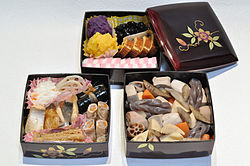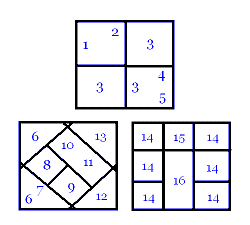Osechi


Osechi-ryōri( ngự tiết liệu lý, お tiết liệu lý or おせち) are traditionalJapanese New Yearfoods. The tradition started in theHeian period(794–1185).[1]Osechiare easily recognizable by their special boxes calledjūbako( trọng rương ), which resemblebentōboxes. Likebentōboxes,jūbakoare often kept stacked before and after use.
Examples of osechi dishes
[edit]The dishes that make uposechieach have a special meaning celebrating the New Year. Some examples are:
- Daidai( cam, だいだい),Japanese bitter orange.Daidaimeans "from generation to generation" when written in differentkanjias đại 々. Likekazunokobelow, it symbolizes a wish for children in the New Year.
- Datemaki( y đạt quyển or y đạt quyển き or だてまき), sweet rolled omelette mixed with fish paste or mashed shrimp. They symbolize a wish for many auspicious days. On auspicious days ( tình れ の ngày,hare-no-hi), Japanese people traditionally wear fine clothing as a part of enjoying themselves. One of the meanings associated with the second kanji includes "fashionability", derived from the illustrious dress of thesamuraifromDateHan.
- Kamaboko( bồ mâu, かまぼこ), broiled fish cake. Traditionally, slices of red and whitekamabokoare alternated in rows or arranged in a pattern. The color and shape are reminiscent of Japanrising sun,and have a celebratory, festive meaning.
- Kazunoko( số の tử, かず の こ),herringroe.Kazumeans "number" andkomeans "child". It symbolizes a wish to be gifted with numerous children in the New Year.
- Konbu( Côn bố ), a kind ofseaweed.It is considered to sound like the wordyorokobu,meaning "joy".
- Kuro-mame( hắc đậu, くろまめ),black soybeans.Mamealso means "health", symbolizing a wish for health in the New Year.
- Kōhaku-namasu(Hồng bạch なます),literally "red-white vegetablekuai",is made ofdaikonand carrot cut into thin strips and pickled in sweetened vinegar withyuzuflavor.
- Tai( điêu, たい),red sea-bream.Taiis associated with the Japanese wordmedetai,meaning auspicious, as to welcome auspicious events for the new year.
- Tazukuri( điền làm り), driedsardinescooked insoy sauce.The literal meaning of the kanji intazukuriis "rice paddy maker", as the fish were used historically to fertilize rice fields. The symbolism is of an abundant harvest next year.
- Zōni(Tạp nấu),a soup ofmochirice cakes in clear broth (in eastern Japan) ormisobroth (in western Japan).
- Ebi( hải lão, えび), skeweredprawnscooked withsakeandsoy sauce.It symbolizes a wish for a long-life, suggesting long beard and bent waist.
- Nishiki tamago( cẩm trứng / nhị sắc ngọc tử ), egg roulade; the egg is separated before cooking, yellow symbolizing gold, and white symbolizing silver, both of these together symbolising wealth and good fortune.
- Zenzaiis a hot dessert soup made of sweet red beans and often served with toasted rice cakes (mochi) or smaller shiratama dango (mini rice cakes). It is similar toshiruko.
History
[edit]The termosechioriginally referred too-sechi,a season or significant period.New Year's Daywas one of the five seasonal festivals in theImperial Court in Kyoto.This custom of celebrating particular days was introduced fromChinainto Japan.
Originally, during the first three days of the New Year, it was taboo to use a hearth and cook meals, except when cookingzōni.Osechi was made by the close of the previous year, as women did not cook in the New Year.
In the earliest days,osechiconsisted only ofnimono,boiled vegetables withsoy sauceandsugarormirin.Over the generations, the variety of food included inosechihas increased. Today it may refer to anything prepared specially for the New Year, and some foreign dishes have been adopted as "Westernizedosechi"( Tây Dương お tiếtseiyō-osechi). And whileosechiwas traditionally prepared at home, it is also sold ready-made in specialty stores, grocery stores, and even convenience stores, such as7-Eleven.
Especially in households whereosechiis still homemade,toshi-koshi soba( năm càng し kiều mạch ) is eaten onNew Year's Eve.Its name literally means "year-crossing soba". Although there may be some symbolism attributed to it (i.e., long life, health and energy in the upcoming year), this tradition may be regarded as largely pragmatic: the traditional wife, busy cooking several days' worth of food for everyone, would likely prefer to make something simple for immediate consumption. It is considered bad luck by many Japanese to leave anytoshi-koshi sobauneaten.
See also
[edit]References
[edit]- ^Editor, Weekender (2020-12-01)."Osechi Ryori: The Meaning Behind Japan's Traditional New Year Food".Tokyo Weekender(in Japanese).Retrieved2024-03-03.
{{cite web}}:|last=has generic name (help)
- "Osechi ryōri".Japan: An Illustrated Encyclopedia.Ed. Alan Campbell & David S. Noble. Tokyo:Kōdansha,1995.


